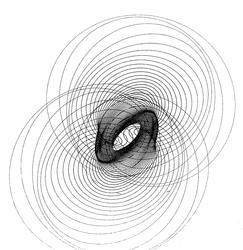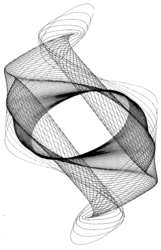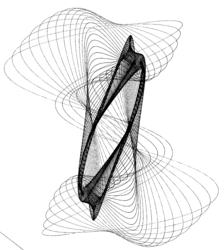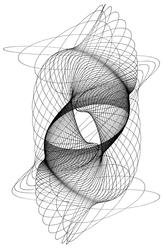Twin Elliptic Pendulum Harmonograph Drawings
Ratios Larger Than 1:1
The Twin Elliptic Pendulum Harmonograph combines two separate conical motions around a single axis by suspending a “deflector” pendulum below the main pendulum. There are several different ways to configure a Twin Elliptic Pendulum, but they are usually comprised of a moving drawing table with a pen arm that floats up and down vertically from a separate fixed support.
Interesting Properties of the Twin Elliptic Pendulum
With the Twin Elliptic Pendulum, a 1:1 ratio cannot be achieved. The nicest drawings are produced when the ratios are higher, such as with a 3:1 or 5:3 ratio. It can be demonstrated that when both pendulums are rotated in the same direction (concurrent motion) at a ratio of X:Y, the drawings produce X-Y cusps (or loops); and if the pendulums are rotated in opposite directions (counter-current motion), then a ratio of X+Y cusps is produced. When the X and Y are both odd, symmetrical drawings are produced in both concurrent and counter-current pendulum motion (examples: 3:1 or 5:3 ratios). The 2:1 motion produces a deltoid figure and the 3:1 produces the asteroid; with more complex hypocycloids created at other ratios.
Motion and Ratio Adjustments
It takes a bit of practice to achieve counter-current motion with the Twin Elliptic Pendulum. It also takes some practice (and a bit of trial and error) to produce a perfect “tuning” of the pendulum periods so that precise ratio’s of motion can be achieved. As a simple rule of thumb: You increase the ratio by either raising (or lightening) the upper pendulum; or lowering (or adding weight) to the lower deflector pendulum. Note that frictional dampening becomes more apparent as the x and y are increased.
Click on the drawings below to see them full sized.




